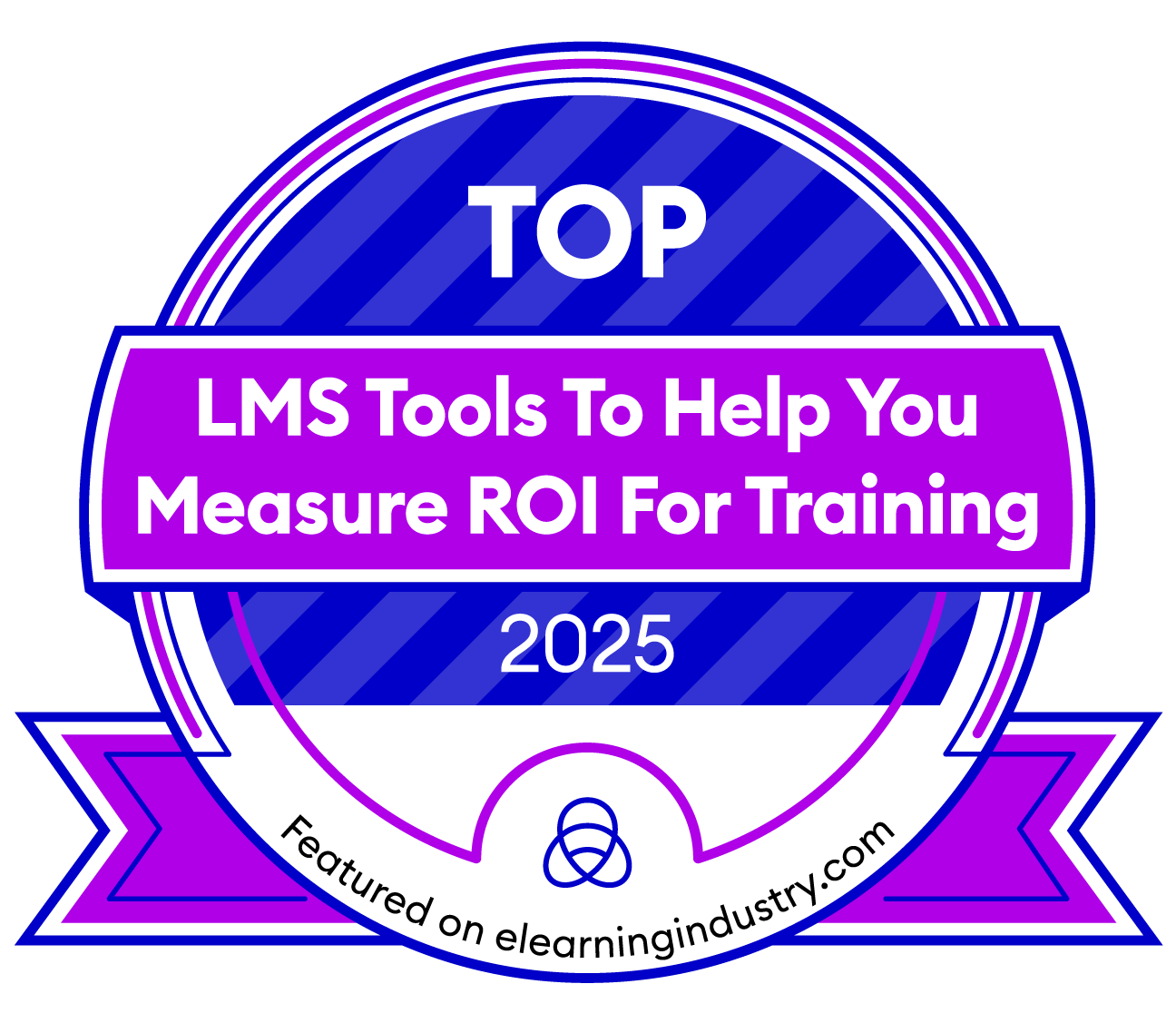Companies pour an average of $1,200 to $1,600 per employee annually into L&D. Yet the nagging question persists, “Is it actually working?”
Without concrete proof of impact, training programs risk being relegated to the “nice-to-have” category of the company budget rather than recognized as the major drivers of growth they truly are.
The harsh reality is that countless training initiatives fail to deliver tangible results when they are measured against hard numbers.
To change that narrative, we need to look at all the ways you can measure ROI to help us get a better idea of the massive impact training can have.
This guide will help you unpack the intricacies of training ROI, so that you can prove the true value of your L&D investments. We’ll show you 7 ways to measure ROI, along with key metrics to monitor.
What is ROI?
In the simplest terms, ROI (return on investment) is the profit you make from an investment, compared to the cost of that investment.
Remember the story of little Johnny and his lemonade stand?
He spent $5 on lemons, sugar, and cups and made $20 from selling ice-cold glasses of lemonade on a hot summer day.
His ROI? A massive 300%.
To get the ROI percentage, we use a little formula you might also remember from school:
- ROI ((Return ➖ Investment) ➗ Investment) ✖ 100
Applying this formula to Johnny’s venture, we can see that:
- His return was $20. And his investment was $5.
- So his ROI would be (($20 ➖ $5) ➗ $5) ✖ 100 300%
What is training ROI?
Now, let’s say Johnny invested in some “training” (aka learning & development).
Through this training, he learned a delicious new lemonade recipe, how to decorate his stand, and even how to charm his customers with a smile. Thanks to this, his sales have tripled.
This extra profit is what we call training ROI.
Unlike the regular ROI we just looked at, this one is for the money you spend on improving your employees’ skills and knowledge.
Why is measuring training ROI important?
A couple of years go by, and Johnny’s lemonade stand has grown into a busy business with more demand than he can supply. He decides it’s time to expand more and pitches to the Sharks for an investment.
As we all remember, they’re not just going to hand over their money because his lemonade tastes good—they want to see what the numbers are saying.
One thing Johnny can do is go beyond the basic ROI and dig into the training ROI. By proving that his training investments in learning new skills paid off big time, he can further prove the value of his business model and case.
In the real world, your C-suite is like the Sharks. They need to see the financial accountability of your L&D and training initiatives to justify the investment to stakeholders. It also helps secure continued funding for training programs and supports new L&D and training initiatives.
But, as we all know, financial returns aren’t just about increased profits. It comes in many forms, just like the different ways Johnny’s training boosted his lemonade stand.
7 ways to measure training ROI
Measuring training ROI is sometimes seen as difficult.
But it doesn’t have to be.
Depending on your situation, you can use one or a combination of the following ways to measure it.
From numbers 1 to 4 we’ll cover the quantitative ways, and from numbers 5 to 7 we’ll explain three qualitative ways.
1. Use the training ROI formula
So, how do you actually calculate training ROI?
It’s not much different from the other example we used before.
Let’s say Johnny invested $100 in his “training program”. After his training, his monthly profit jumped from $500 to $800.
Here’s how we calculate his training ROI for that month:
- His return is $800 ➖ $500 $300
- His investment is $100
- So his, ROI is (($300 ➖ $100) ➗ $100) ✖ 100 200%
This means for every dollar he invested in his training program, he got two dollars back in profit.
Of course, in the real world, calculating training ROI can be more complex. You’ll need to consider more factors than what we covered.
But the basic principle remains the same:
- Training ROI ((Benefits of training ➖ Cost of training) ➗ Cost of training) ✖ 100
2. Expanding on the classic ROI formula
Just as Johnny’s lemonade stand grew beyond a simple recipe and a sunny afternoon, so too does the calculation of training ROI in the workplace.
After being funded, Johnny now has a sizable workforce. Just like he did with himself, he decided to invest in a customer service training program for his team.
The benefits here aren’t just a simple uptick in sales. They’re a symphony of positive changes, including:
- Happy customers
- Faster service
- Valued and trained employees who are less likely to leave
- A boost in Johnny’s brand, drawing new customers and loyalty
The cost of training also extends beyond the price tag of the training program itself. Johnny needs to consider:
- Direct training costs like the training program, training materials, and any external trainers or consultants.
- Indirect training costs like the time employees who are training participants spend away from their regular duties while attending training sessions.
With all this in mind, Johnny decides to invest in a new program. The program costs $5,000, but after completing it, his monthly profit goes up by $3,000. On top of that, he thinks he’s saving $2,000 because his employees are sticking around longer.
To calculate his training ROI, Johnny needs to:
- Calculate the total benefits: $3,000 (increased profit) ➕ $2,000 (reduced turnover) $5,000
- Calculate total training costs: $5,000 (training program cost) ➕ $1,000 (estimated employee time cost) $6,000
- Apply the ROI Formula: (($5,000 ➖ $6,000) ➗ $6,000) ✖ 100 -16.66%
In this scenario, Johnny’s initial training ROI is negative. However, remember that some benefits, such as improved brand reputation and employee morale, are difficult to quantify immediately.
Over time, these intangible benefits can lead to significant financial gains, turning a seemingly negative ROI into a positive one (more on this in steps 5 to 7).
3. Set relevant Key Performance Indicators (KPIs)
When Johnny first calculated how much money he made from his first employee training, he realized he would need to look at how well it worked beyond just looking at overall profits. He realized he needed specific metrics to figure out the exact gains from his investment. That’s where Key Performance Indicators (KPIs) come in handy.
Johnny started tracking several KPIs, each tied to specific aspects of the customer service training program. The metrics he kept an eye on were:
- Customer satisfaction
- Average sale value
- Repeat business
To set a baseline, Johnny gathered data about these KPIs from before the training program. For example, the average customer satisfaction score was 3.8, the average sale value was $5, and repeat business was at 20%.
He then measured the results to see if there were any improvements:
- The customer satisfaction increased to 4.5
- The average sale value increased to $6
- Repeat business increased by 30%
These improvements gave him a clear indicator that the training program was paying off in more ways than he thought.
4. Perform a Cost-Benefit Analysis (CBA)
As Johnny’s lemonade empire expanded, he considered launching a new line of flavored lemonades. He knew that teaching his team the new recipes and preparation methods would be really important for this new venture to succeed.
However, hiring a specialized consultant for the employee training came with a hefty price tag. This prompted Johnny to do a Cost-Benefit Analysis (CBA).
Johnny started by listing the potential costs associated with the training:
- Consultant fees — $2,000
- Employee time away from regular duties — Estimated at $500
- Potential productivity loss during training — Estimated at $300
Next, he outlined the potential benefits of the new product line training:
- Increased sales — Projected at $5,000 per month
- Enhanced brand image and customer appeal — Difficult to quantify but helps for long-term growth
While the CBA was Johnny’s financial guide, he knew it had limits. Some things, like brand image and customer loyalty, were hard to put a price on. Also, CBA didn’t consider risks or surprises that could affect the success of the new products.
Therefore, Johnny considered qualitative factors alongside the financial ones:
- Would the new training sessions excite and motivate his team?
- Have customers expressed interest in flavored lemonades?
- Was there a growing demand for flavored beverages?
After weighing the costs, potential benefits, and qualitative factors, Johnny concluded that the potential gains from the new product line outweighed the training costs. He recognized that while the initial investment might seem steep, the long-term benefits for his brand and customer base justified the expense.
5. Launch surveys and gather feedback
Remember how Johnny’s lemonade stand thrived when he started paying attention to what his customers wanted?
The same principle applies to training ROI—you need to listen to your employees to understand how your training is impacting them. Something that you can do using surveys and feedback.
To help do that, Johnny used pre-training surveys to gauge his employees’ existing knowledge and expectations. This helped him better build his training content to suit their specific needs and to identify any skill gaps that needed addressing.
After the training, he conducted post-training surveys to assess:
- Learning effectiveness
- Skill application
- Overall satisfaction
He then analyzed the surveys and feedback to identify where the training had made the biggest impact.
One thing Johnny could do to simplify this step is to use employee training software. With this software, you can send, create, and analyze surveys much easier and faster than doing it manually.
6. Make observations and identify success stories
Johnny, being a hands-on business owner, understood the power of direct observation. He made it a point to regularly interact with his team and kept an eye on their behavior and performance before and after training sessions.
Before the customer service training, Johnny noticed certain patterns that he kept a record of:
- Some employees struggled to handle difficult customers, leading to frustrated interactions.
- Others lacked confidence in recommending additional products, missing out on upselling opportunities.
- There was a general inconsistency in service quality, impacting customer satisfaction.
After the training, Johnny observed positive changes:
- Employees handled challenging situations with greater composure and empathy.
- They proactively suggested additional products and offered personalized recommendations.
- The overall service experience became more consistent and polished.
While not directly linked to direct ROI, these observations and increases in performance can greatly impact the overall performance of the company.
Something echoed by Dr. Keating on the “Making learning a business priority” episode of our podcast, “[…] Instead of focusing solely on traditional ROI, highlight success stories of employees who improved or stayed because of training. These stories showcase the true impact of L&D.”
7. Host interviews and focus groups
Following observations, Johnny decided to conduct interviews and focus groups to gather more detailed qualitative data on the impact of his training programs.
Johnny asked a few employees and managers to join focus groups. Here they could talk openly about their training experiences and share their thoughts on how it affected them. He also conducted one-on-one interviews with a few select people to dig deeper into their personal journeys.
After that, he learned about the skills people learned, the problems they had, how the training had changed how they worked, and even how they felt about their jobs.
The value of this data is immense. It can help you make your training better and help you see what’s working well and what employees have learned.
In a nutshell, this data can help you state the case for your calculating ROI for training beyond just numbers.
Remember the ROI we calculated earlier? Well, with all this data, Johnny can see that the benefits (beyond just cost) far outweigh the cost and that his business is thriving because of it.
Important training ROI metrics
Just like Johnny kept a close eye on his lemonade stand’s success, tracking the right metrics is key to proving the value of your training investment.
Financial metrics
These metrics hit where it often matters most—the bottom line:
- Return on investment (ROI) is the North Star, showing you the bang for your training buck.
- Customer lifetime value measures if the training resulted in more loyal customers and long-term profits.
- Revenue growth indicates if your sales team’s performance has improved and is bringing in more money.
- Profit margins show if the training made the business more efficient and led to better profits.
- Cost savings demonstrate how much money was saved due to process improvements or increased employee efficiency.
- For service-based businesses, time equals money. The billable hours metric measures if training led to more billable hours.
Performance metrics
Beyond the balance sheet, these metrics capture how training impacts how your team gets work done:
- Reaching goals in learning and development is directly linked to both personal and team performance goals.
- Innovation is all about keeping an eye on groundbreaking ideas.
- Productivity measures how much more work an employee can get done, or how much more can be accomplished in an hour.
- Quality tracks how much work quality improves after training.
- Customer satisfaction checks if training enhances the overall customer experience.
- Speed to market evaluates if training has led to faster product development or quicker product launches.
Employee-centric metrics
Remember, your employees are your most valuable asset. These metrics show how training impacts their engagement and growth:
- Employee engagement captures the increased commitment and involvement of your team.
- Employee retention tracks if training has helped reduce turnover rates.
- Time to proficiency measures if training accelerated their learning curve.
- Internal promotion rates tracks career advancement opportunities spurred by L&D.
- Employee satisfaction gauges overall employee contentment and well-being post-training.
- Absenteeism and tardiness monitors any reduction in absenteeism or tardiness following training
Take a holistic approach to training ROI
Sure, a positive ROI is fantastic.
But what’s even better?
A team that’s skilled, motivated, and genuinely passionate about their work. That’s the kind of investment that’ll keep your business thriving for years to come.
Just like Johnny’s journey from a simple lemonade stand to a booming business shows, training ROI isn’t just about cold, hard numbers.
It’s about seeing the bigger picture of how your L&D efforts, training programs, and future training initiatives pay off.
Ensuring training effectiveness will give you the business outcomes you seek.
And the ROI of training will translate to happier employees, satisfied customers, a culture of learning, and even innovation.
Originally published on: 08 Feb 2023 | Tags: Learner Engagement,Training ROI





